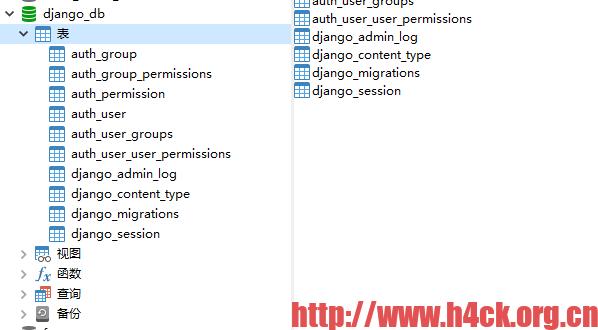当前位置:首页 » python web » 正文
通过官方文档https://docs.djangoproject.com/zh-hans/3.1/topics/db/multi-db/和csdnhttps://blog.csdn.net/songfreeman/article/details/70229839的这两篇文章可以进行多数据库的设置。但是设置后可能会出现问题,由于我连接的数据库是通过inspactdb的方法得到的model。于是在migrate的时候出现了问题,会提示 1146, “Table xxx doesn't exist” 。后来发现问题可能出在路由表上,按照DATABASE_APPS_MAPPING映射之后,django默认的表如果要写入可能会找不到数据库。而源代码里的映射关系并不包含新加入的app,例如grappelli等。
DATABASE_APPS_MAPPING = { # example: # 'app_name':'database_name', # 'admin': 'default', # 'users': 'default', #django 'basic_estate': 'basic_estate', 'footstone': 'footstone', 'mall': 'hsmall', 'iot_biz': 'iot_biz', 'mall': 'mall', 'hsuser': 'hsuser', }如果要解决这个问题可以修改router代码,在映射关系内找不到对应的数据库的情况下返回默认数据库连接即可:
# -*- coding: utf-8 -*- """ @author: obaby @license: (C) Copyright 2013-2020, obaby@mars. @contact: root@obaby.org.cn @link: http://www.obaby.org.cn http://www.h4ck.org.cn http://www.findu.co @file: atabase_router.py.py @time: 2021/2/26 9:07 @desc: """ from django.conf import settings DATABASE_MAPPING = settings.DATABASE_APPS_MAPPING class DatabaseAppsRouter(object): """ A router to control all database operations on models for different databases. In case an app is not set in settings.DATABASE_APPS_MAPPING, the router will fallback to the `default` database. Settings example: DATABASE_APPS_MAPPING = {'app1': 'db1', 'app2': 'db2'} """ def db_for_read(self, model, **hints): """"Point all read operations to the specific database.""" if model._meta.app_label in DATABASE_MAPPING: return DATABASE_MAPPING[model._meta.app_label] return 'default' def db_for_write(self, model, **hints): """Point all write operations to the specific database.""" if model._meta.app_label in DATABASE_MAPPING: return DATABASE_MAPPING[model._meta.app_label] return 'default' def allow_relation(self, obj1, obj2, **hints): """Allow any relation between apps that use the same database.""" db_obj1 = DATABASE_MAPPING.get(obj1._meta.app_label) db_obj2 = DATABASE_MAPPING.get(obj2._meta.app_label) if db_obj1 and db_obj2: if db_obj1 == db_obj2: return True else: return False return None def allow_syncdb(self, db, model): """Make sure that apps only appear in the related database.""" if db in DATABASE_MAPPING.values(): return DATABASE_MAPPING.get(model._meta.app_label) == db elif model._meta.app_label in DATABASE_MAPPING: return False return None def allow_migrate(self, db, app_label, model=None, **hints): """ Make sure the auth app only appears in the 'auth_db' database. """ if db in DATABASE_MAPPING.values(): return DATABASE_MAPPING.get(app_label) == db elif app_label in DATABASE_MAPPING: return False return None这样django系统所需的数据库就能正常创建了:

总结
到此这篇关于django使用多个数据库的文章就介绍到这了,更多相关django多数据库内容请搜索python博客以前的文章或继续浏览下面的相关文章希望大家以后多多支持python博客!
-
<< 上一篇 下一篇 >>
标签:django
django使用多个数据库的方法实例
看: 1582次 时间:2021-03-09 分类 : python web
- 相关文章
- 2021-07-20django学习之ajax post传参的2种格式实例
- 2021-07-20Python djanjo之csrf防跨站攻击实验过程
- 2021-07-20django admin实现动态多选框表单的示例代码
- 2021-07-20Flask登录注册项目的简单实现
- 2021-07-20Flask实现异步执行任务
- 2021-07-20如何使用flask将模型部署为服务
- 2021-07-20Django实现自定义路由转换器
- 2021-07-20python flask框架快速入门
- 2021-07-20Django 聚合函数的具体使用
- 2021-07-20django时区问题的解决
-
搜索
-
-
推荐资源
-
Powered By python教程网 鲁ICP备18013710号
python博客 - 小白学python最友好的网站!